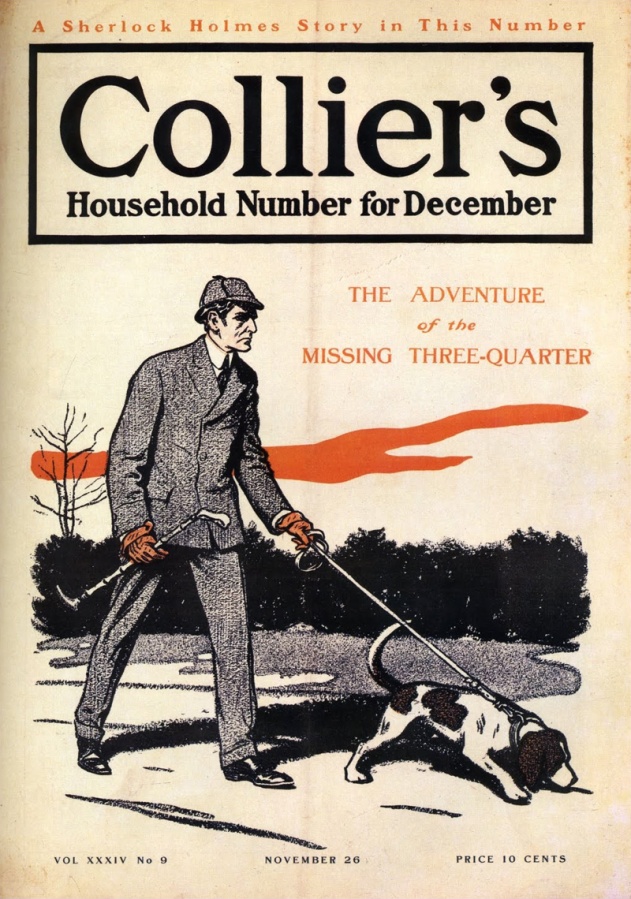A Scion Society of The Baker Street Irregulars

The 17 Steps: The Missing Three-Quarter
Seventeen thoughts for further ponderance of the case at hand – The Missing Three-Quarter (MISS)

SHERLOCK WASN’T THE ONLY ONE RUNNING IN THE STRAND
“Strand postmark, and dispatched ten thirty-six,” said Holmes, reading it over and over. “Mr. Overton was evidently considerably excited when he sent it, and somewhat incoherent in consequence.”
What might a young rugby player, having come up to play Oxford, be doing in the Strand? Was a sensible place to send a message on one’s way from Scotland Yard to Baker Street?
RUGBO-BABBLE FOR DUMMIES
“He’s simply the hinge that the whole team turns on. I’d rather spare two from the pack, and have Godfrey for my three-quarter line. Whether it’s passing, or tackling, or dribbling, there’s no one to touch him, and then, he’s got the head, and can hold us all together. . . . There’s Moorhouse, first reserve, but he is trained as a half, and he always edges right in on to the scrum instead of keeping out on the touchline. He’s a fine place-kick, it’s true, but then he has no judgment, and he can’t sprint for nuts. Why, Morton or Johnson, the Oxford fliers, could romp round him. Stevenson is fast enough, but he couldn’t drop from the twenty-five line, and a three-quarter who can’t either punt or drop isn’t worth a place for pace alone.”
Okay, slowly and simply, can someone explain this paragraph for us, point by point?
HIS MATE WAS A MIGHTY RUGBY MAN, THE SKIPPER BRAVE AND SURE …
“I am the skipper of the Rugger team of Cambridge ‘Varsity.” announces Cyril Overton. He’s keeping the team in training, but he’s playing, too. Would this team have had a coach, or any non-playing advisers?
Why is Overton carrying the ball in finding Staunton?
AND ON MR. BLACKWELL’S LIST FOR 1896
“He was dressed in rusty black, with a very broad-brimmed top-hat and a loose white necktie–the whole effect being that of a very rustic parson or of an undertaker’s mute.”
For starters: what color is “rusty black”? But why would one of the richest men in London dress like a country parson? Were parson outfits cheaper than regular formalwear?
THE ENUMERATED SHERLOCK HOLMES
“I had seven different schemes for getting a glimpse of that telegram, but I could hardly hope to succeed the very first time.”
The Hounds have speculated upon these seven schemes before, but my question for you this time out is this: Did Holmes have time to come up with these seven schemes on his way to the telegraph office, or did he come up with such things at other times, make up lists, and hence was quite proud that he had seven ready to go?
SO THEY TOOK STAUNTON OUT ON THE MOOR WITH A CATARACT KNIFE …
“Amateur sport is free from betting, but a good deal of outside betting goes on among the public, and it is possible that it might be worth someone’s while to get at a player as the ruffians of the turf get at a race-horse.”
This may seem a subject more suited for “Silver Blaze,” but how did the ruffians of the turf get at race-horses? Did they often outright steal them, as someone seems to have done with Staunton?
THE LATEST POP STAR OF THE MEDICAL WORLD
Watson writes: “It argues the degree in which I had lost touch with my profession that the name of Leslie Armstrong was unknown to me. Now I am aware that he is not only one of the heads of the medical school of the university, but a thinker of European reputation in more than one branch of science.”
Wait a minute … it’s only been two years since Watson gave up his practive, hasn’t it? And wasn’t he reading a surgical treatise, even after that? (Publication date 1904, Watson says it’s been seven or eight years when he wrote it. More in Monday’s Chronology Corner.) Did Leslie Armstrong rise to medical fame all that quickly? And even if Watson was a practicing doctor, would we expect him to know who this guy was?
WATSON’S YEARS OF WEANING
“For years I had gradually weaned him from that drug mania which had threatened once to check his remarkable career.”
When is Watson talking about in this statement? When Holmes seemed to be at his highest level of drug use, Watson was deserting him for Mary Morstan. Long periods of time passed during Watson’s marriage(s) when he didn’t see Holmes at all. So when did he have time for *years* of weaning?
THE APOSTROPHE THAT’S NOW HISTORY
“To-morrow is the ‘Varsity football match.”
Here’s one of those questions that’s probably clear as glass in England, but seems a bit odd in America. Why is “’Varsity” looking like a contraction with that apostrophe in front of it?
THE THIRTEEN GUINEA DOCTOR’S BILL
“Then perhaps you will explain this receipted bill for thirteen guineas, paid by Mr. Godfrey Staunton last month to Dr. Leslie Armstrong, of Cambridge. I picked it out from among the papers upon his desk.”
From the papers on the desk, Holmes has plucked a single bill. As Mrs. Staunton had an ongoing illness, would the bill have been for services over a period of time or an individual treatment? Was a famous doctor like Armstrong charging a student his going rate, and if not, what was he basing that thirteen guineas on? It’s a very odd, almost ominous, amount for an arbitrary figure, isn’t it?
IRRITATING THE WITNESS
“’Dear me, dear me–the postoffice again!’ Holmes sighed, wearily. ‘A most urgent telegram was dispatched to you from London by Godfrey Staunton at six-fifteen yesterday evening–a telegram which is undoubtedly associated with his disappearance–and yet you have not had it. It is most culpable. I shall certainly go down to the office here and register a complaint.’
“Dr. Leslie Armstrong sprang up from behind his desk, and his dark face was crimson with fury.”
Why is Holmes taunting Armstrong? Doesn’t he actually expect to get anything out of him with such tactics, or has he decided that Armstrong is a villain and now enjoys tormenting him?
WORKING LATE AGAIN
All Hounds who’ve ever held supper for a late-working spouse can sympathize with Mrs. Hudson’s dilemmas in feeding Holmes. But at the inn he and Watson are staying at, the landlord doesn’t seem to be too concerned:
“These few inquiries proved, however, to be a more lengthy proceeding than Holmes had imagined, for he did not return to the inn until nearly nine o’clock. He was pale and dejected, stained with dust, and exhausted with hunger and fatigue. A cold supper was ready upon the table …”
How long would supper have been sitting there? What might a typical cold supper have consisted of?
THE LITERARY DOCTOR OF CAMBRIDGE
“But Armstrong is not really a doctor in practice. He is a lecturer and a consultant, but he does not care for general practice, which distracts him from his literary work.”
Leslie Armstrong was a man of science, who is busy writing a treatise during this tale. Was the public’s perception of “literary” broader in Victorian times?
THE BEST LOCATION IN THE CANON
The inn Holmes and Watson are staying at is perhaps the most convenient they’ve ever encountered: it’s across the street from a prime suspect and, “There is, as you may have observed, a bicycle shop next to our inn. Into this I rushed, engaged a bicycle …”
How common would a shop specializing in bicycles have been in Victorian times? Was this something one might find in a college town, but not a similar city without a yearly influx of young people?
THE HEADLESS HORSEMAN DID IT!
“The daily appearance of a brougham and pair could hardly have been overlooked in such Sleepy Hollows.”
Is the capitalization of “Sleepy Hollows” an indication that Holmes is referring to the Washington Irving tale? Or might Holmes have been saying lower case “sleepy hollows,” only to have it interpretted in a literary fashion by Watson, the real reader of fiction in the house?
THE OBJECT OF WATSON’S HORROR
“I was horrified by my first glimpse of Holmes next morning, for he sat by the fire holding his tiny hypodermic syringe. I associated that instrument with the single weakness of his nature, and I feared the worst when I saw it glittering in his hand.”
Is Watson’s horror at this simple object a sign that there is more to Holmes’s addiction than he wrote of in his chronicles? Or were the drug incidents we’ve read enough to spur such a statement on their own? Why is Holmes carrying aniseed around in a syringe, anyway? Wouldn’t a small bottle, poured over the carriage wheel, have worked just as well?
THOSE BLOODHOUNDS WILL WORK FOR ANYBODY
Pompey, the pride of the local draghounds, does an excellent job for Holmes and Watson, two men he’s never seen before the Staunton case. Is it normal for a draghound to work well with strangers? Shouldn’t Pompey’s master have come along to get his best performance?
The Seventeen Steps originally appeared on the Hounds of the Internet e-list from September 2000 to October 2001 and later on the Sherlock Peoria blog.
 Brad Keefauver, the 41st Garrideb, is the author of The Elementary Methods of Sherlock Holmes, Sherlock and the Ladies, and The Armchair Baskerville Tour. Former publisher of The Holmes & Watson Report, The Dangling Prussian, and a whole lot of obscure, collectable little things on our boy Sherlock. Keefauver is a member of the Baker Street Irregulars and the Adventuresses of Sherlock Holmes.
Brad Keefauver, the 41st Garrideb, is the author of The Elementary Methods of Sherlock Holmes, Sherlock and the Ladies, and The Armchair Baskerville Tour. Former publisher of The Holmes & Watson Report, The Dangling Prussian, and a whole lot of obscure, collectable little things on our boy Sherlock. Keefauver is a member of the Baker Street Irregulars and the Adventuresses of Sherlock Holmes.

Sorry, comments are closed for this post.